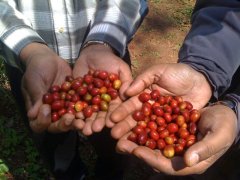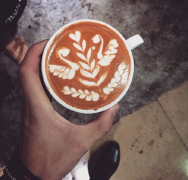How is decaf made?
At present, there are three ways to remove caffeine from coffee beans:
1. Water treatment can remove 9496% caffeine.
2, chemical extraction method, early use chloroform (Chloroform), benzene (Benzene) as the solvent to extract caffeine, later understand that these chemicals cause cancer, and gradually be replaced by other low-hazard chemicals, but after all, the chemical substances are not natural enough, this method can extract 96% of caffeine.
3. The third method is supercritical carbon dioxide treatment, and its extraction rate can reach 960.98%. The most efficient of the three ways to remove caffeine.
Carbon dioxide (CO2) treatment:
Two natural elements, pure water and carbon dioxide (a mixture of the two we often call soda) are used to extract caffeine from raw coffee beans. The founder of this method is Kurt Zosel.
In chemistry, we also call it supercritical CO2 extraction technology. The density of supercritical carbon dioxide (hereinafter referred to as SC-CO2) is hundreds of times that of gas and close to that of liquid, but its viscosity is similar to that of gaseous carbon dioxide. Its diffusion coefficient is about 1% of that of a gas and hundreds of times larger than that of a liquid. Therefore, the movement (Mass transfer) or distribution of substances is faster than that in liquid solvents.
This method was developed to extract caffeine from coffee beans because of the following characteristics:
1. The critical temperature of carbon dioxide is 31.1 ℃ and the critical pressure is 73 atmospheric pressure (Atm). It is suitable for the extraction of thermally unstable substances because it is close to the critical temperature at room temperature. It has a good effect on the retention of aroma substances in coffee.
two。 Carbon dioxide is an inactive gas, has no flammability and chemical reactivity, has no residue, is harmless to human body, and does not cause environmental pollution.
3. It is easy to obtain high-purity carbon dioxide and cheap.
The method of supercritical CO2 extraction of caffeine is to make coffee beans absorb water and expand to twice as large. Caffeine molecules move in the bean body, add carbon dioxide and give more than 100 atmospheric pressure (Atm) in the water, so that water and carbon dioxide are mixed to create a soda environment. Carbon dioxide attracts caffeine molecules like a magnet, and when caffeine is captured by carbon dioxide, caffeine begins to move. Carbon dioxide is highly selective and it does not capture carbohydrates and proteins in coffee beans because carbohydrates and proteins are the main components of flavor and smell in coffee beans. When it dries naturally after the extraction, caffeinated water can be easily separated from caffeine and used for other commercial purposes.
Advantages of this method:
1. The extraction efficiency of caffeine is very high, and there is no chemical pollution.
two。 It will not have any chemical changes with carbohydrates and proteins in coffee beans.
3. Its by-product (caffeine) is natural and 100% recyclable!

Important Notice :
前街咖啡 FrontStreet Coffee has moved to new addredd:
FrontStreet Coffee Address: 315,Donghua East Road,GuangZhou
Tel:020 38364473
- Prev

Characteristics and Flavor changes of different treatments of Coffee and Raw Bean
Coffee fermentation is one of the most important steps in wet processing of coffee, which is related to the quality of coffee. Many people will ask what is the reason for fermentation? This problem is generally said to be for degumming; in fact, the mucus on the endocarp of coffee is an organic substance composed of sugar, enzyme, propectin and pectin, which can be dissolved by natural fermentation by bacteria and is easy to wash off.
- Next

Make the basis of a cup of cotton silk with fine milk foam.
On how to make a good milk bubble, here provides a stupid milk bubble method, that is, pour half of the milk into the steel cup, let the steam pipe and the milk perpendicular to the center or the edge of the steel cup, then let the steam head just touch the surface of the milk, then turn on the steam to 1pm 2, do not move the steel cup, slowly close when the milk reaches 50 degrees, close at 60 degrees, and finally the temperature will reach 6.
Related
- What is the meaning of lactic acid fermentation with coffee bean treatment?
- How to judge the state of foam by sound?
- How does the latte pull out the unicorn pattern? Come to get for a little trick to improve the flower pull!
- Will flower pulling affect the taste of the latte?
- Do you know the history of coffee?
- The difference between honey treatment and sun washing what is raisin honey treatment?
- What kind of milk can a novice use to make coffee foam to keep the foam longer? The correct method and skills of milking tutorial sharing
- Why do washed coffee beans taste sour? Flavor characteristics of washed Coffee
- Introduction to the skill of how to practice the size and height of water injection around the circle of hand-brewed coffee
- How do beginners practice coffee flower drawing from scratch?

